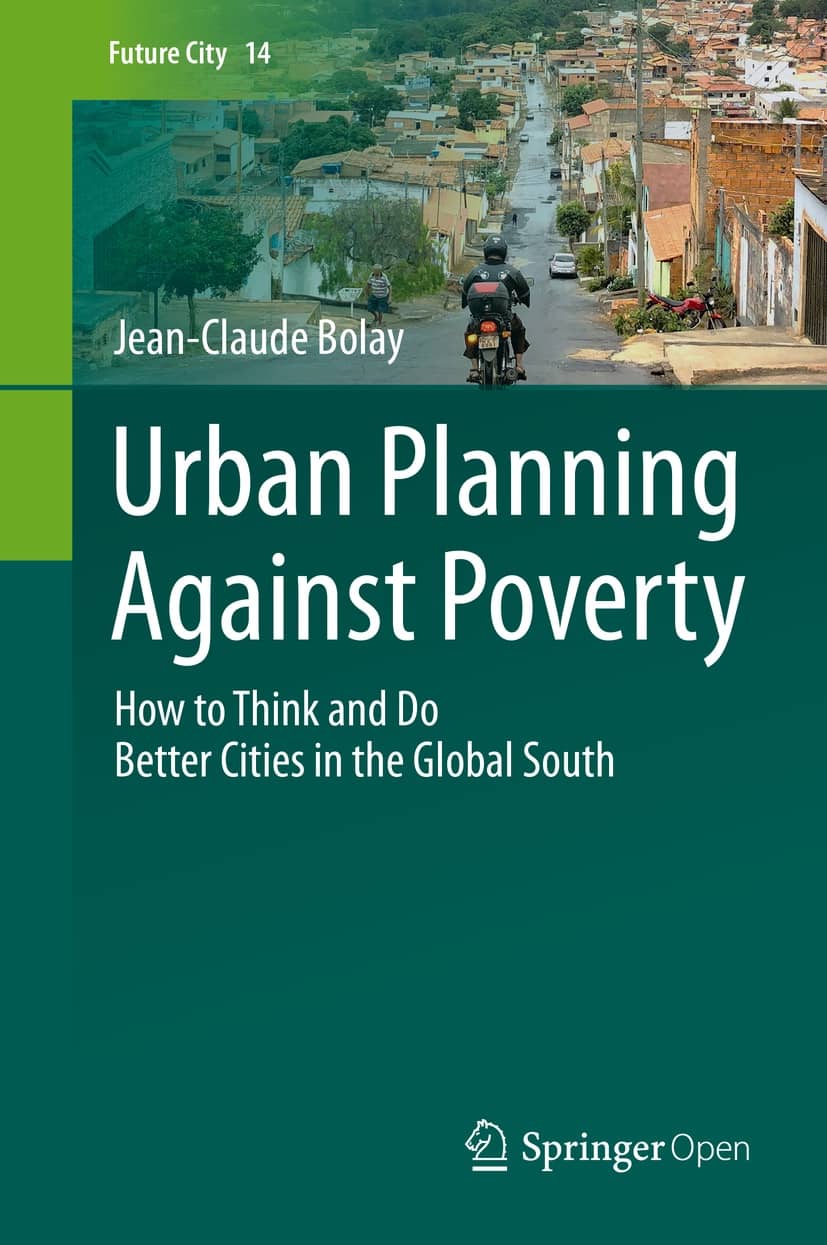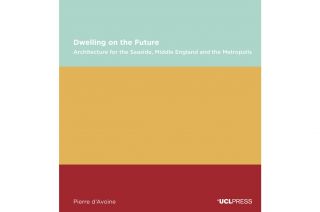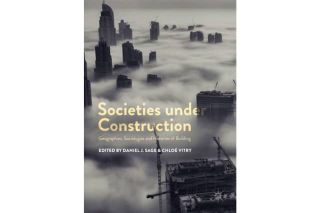
www.buildingsandcities.org/insights/reviews/urban-planning-against-poverty-review.html
Urban Planning Against Poverty: How to Think and Do Better Cities in the Global South
By Jean-Claude Bolay. Springer, 2020, ISBN 9783030284190.
Joshua Kirshner (University of York) reviews this book which explores the foundations of urban planning and their suitability for application in mid-sized cities of the Global South.
 "When it comes to cities in emerging or
developing countries (especially small and medium-sized cities), our thinking
requires an urgent overhaul." So begins Jean-Claude Bolay's Urban Planning Against Poverty, an open
access book in Springer's Future Cities
series. It revisits the conceptual foundations of urban planning and considers their
application in Southern cities. Through diverse international case studies, Bolay
re-envisions approaches to spatial and social planning to better tackle urban poverty
and social exclusion. The author guides us through a rethinking that puts the
needs of urban residents first, without losing sight of persistent obstacles
such as insufficient budgets and capacity building, divergent interests, and deep-seated
structural inequalities. Rather than a focus on mega-city regions, global
cities and other urban formations, Bolay directs our attention to less-known,
mid-sized cities of the Global South.
"When it comes to cities in emerging or
developing countries (especially small and medium-sized cities), our thinking
requires an urgent overhaul." So begins Jean-Claude Bolay's Urban Planning Against Poverty, an open
access book in Springer's Future Cities
series. It revisits the conceptual foundations of urban planning and considers their
application in Southern cities. Through diverse international case studies, Bolay
re-envisions approaches to spatial and social planning to better tackle urban poverty
and social exclusion. The author guides us through a rethinking that puts the
needs of urban residents first, without losing sight of persistent obstacles
such as insufficient budgets and capacity building, divergent interests, and deep-seated
structural inequalities. Rather than a focus on mega-city regions, global
cities and other urban formations, Bolay directs our attention to less-known,
mid-sized cities of the Global South.
In Chapter 2, 'Urban Facts,' Bolay makes the case for the importance of small and medium-sized cities in the Global South as 'intermediate cities' within wider urban networks, advocating for their centrality in global urban agendas given their strategic role in regional economies, their linking of urban and rural worlds via migration, mobility and supply chains, and their growing share of the world's urban residents. Some interesting discussion of rural-to-urban migration flows, drawing on Bolay's doctoral research in central Mexico, is also presented. Chapter 3, 'Global Sustainability: How to Rethink Urban Planning,' highlights the disjuncture between spatial planning methods fostered in developed economies and the pressing needs and aspirations of developing world cities and their residents. Such disjuncture is particularly felt among poorer urban dwellers living precariously with high levels of informality in employment, land, habitat and access to basic services (e.g. water and electricity) and the legacies of colonial planning histories.
Bolay then turns to developing three case studies: one from West Africa and two from South America, covered in Chapters 4-6. First, Koudougou (pop. 120,000), an intermediate city in Burkina Faso-one of the poorest countries in the world-offers scope to understand how these issues translate in the African urban context. The reader encounters a provincial capital whose authorities confront multiple challenges, but are unable to systematically address them due to an insufficient municipal budget and dependence on the central government and international aid agencies. Urban development thus depends less on local consultation than on donor priorities and top-down, state-led decision making. Bolay stresses the need for reinventing planning in the African context while advocating greater autonomy for local actors to decide how best to put it to useful ends.
Second, Nueve de Julio (pop. 50,000), which lies in the Argentine pampas, demonstrates new forms of social exclusion and spatial fragmentation linked to production for agro-export markets in a small-sized city with growing global connections. Founded in the 19th Century amid territorial conquest, the city typifies secondary cities in terms of its relationship to surrounding rural spaces and local-global linkages. With no long-term vision for sustainable urban development, successive municipal governments have allowed longer-term challenges to mount while addressing only the most urgent problems. As a result, it now faces runaway territorial sprawl and has a poor, poorly integrated populace. Sustainability planning is much needed, but leaders are ambivalent about embracing longer-term investments with no visible or immediate effects when local elections loom.
Montes Claros, an agglomeration of some 400,000 residents in Minas Gerais, Brazil, is the third city under study. In 2015, local authorities updated its master plan with support from universities and professional planners and technicians, but with little input or engagement with ordinary residents. Somewhere between non-existent planning (as in the Argentine example) and exogenous, top-down planning (seen in the Burkina Faso case), the Brazilian example allows us to follow an unfolding process. Faced with ongoing demographic growth and a variety of political and economic risks, the authorities are concentrating on the city centre while abandoning its peripheries. Rather than taking the opportunity to extend bottom-up participation and recognize residents' agency in broader urban trajectories, they rely on a techno-economic approach, revealing professional biases in public administration and reinforcing socio-economic privilege and hierarchies.
Before concluding, Bolay puts in perspective the discussion of the three cases to highlight the challenges of pursuing sustainable urban development. Though enormously different in their geo-historical development, each is a lesser-known city serving as a hub for a wider region, tapping into global circulations and infrastructures, and linking surrounding rural spaces. Each faces challenges of service provision, accessibility, liveability and job creation amid rapid (and often unplanned) urban expansion, with new neighbourhoods cropping up on their outskirts.
The book is readable and accessible, integrating perspectives from the literature with the author's own research and three decades of on-site professional experience. It would be a good addition to university courses in planning, urban studies and geography at upper-level undergraduate or masters level. Compelling photos taken by the author are interspersed, and Bolay uses some appealing phrasing, such as when he says "your breath forgets to disembark with you in El Alto airport, 4150m above sea level," (p. 19) in recounting a visit to La Paz, Bolivia. The early chapters are wide-ranging with a wealth of empirical details, but at times unwieldy, lacking clear and succinct summaries to wrap up. A few points seem outdated, such as a mention of NAFTA on p. 21, or "the recent liberalization of international trade rules and instantaneity of telecommunications" on p. 36. Some more recent or emerging trends are neglected, including the hardening of borders and 'de-globalization', the use of algorithms in urban service provision and securitization, or China's and India's engagement in Global South cities' infrastructure.
A related point, Bolay's treatment of the literature frequently relies on sources from the 1990s and 2000s in tracing the evolution of development planning, but equally in attending to current urban dynamics, especially in the framing chapters. Much contemporary, interdisciplinary urban research is overlooked, such as on urban precarity, infrastructural politics and urban sustainability transitions, off-grid cities, nature-based solutions, climate disruption, intersectionality and exclusion. To take just a few tributaries from this (transdisciplinary) river would enrich Bolay's account of the realities in these cities while enhancing his critique of Eurocentric and technocratic planning approaches
That said, the book provides a useful synthesis that broadens our understanding of spatial planning, social integration and poverty alleviation in less-studied, mid-sized cities of economies in transition, where a growing share of humanity resides. It offers valuable insights that can inform planning practice and theoretical understandings of our increasingly urban condition.
Latest Peer-Reviewed Journal Content
Acceptability of sufficiency consumption policies by Finnish households
E Nuorivaara & S Ahvenharju
Key factors for revitalising heritage buildings through adaptive reuse
É Savoie, J P Sapinski & A-M Laroche
Cooler streets for a cycleable city: assessing policy alignment
C Tang & J Bush
Understanding the embodied carbon credentials of modern methods of construction
R O'Hegarty, A McCarthy, J O'Hagan, T Thanapornpakornsin, S Raffoul & O Kinnane
The changing typology of urban apartment buildings in Aurinkolahti
S Meriläinen & A Tervo
Embodied climate impacts in urban development: a neighbourhood case study
S Sjökvist, N Francart, M Balouktsi & H Birgisdottir
Environmental effects of urban wind energy harvesting: a review
I Tsionas, M laguno-Munitxa & A Stephan
Office environment and employee differences by company health management certification
S Arata, M Sugiuchi, T Ikaga, Y Shiraishi, T Hayashi, S Ando & S Kawakubo
Spatiotemporal evaluation of embodied carbon in urban residential development
I Talvitie, A Amiri & S Junnila
Energy sufficiency in buildings and cities: current research, future directions [editorial]
M Sahakian, T Fawcett & S Darby
Sufficiency, consumption patterns and limits: a survey of French households
J Bouillet & C Grandclément
Health inequalities and indoor environments: research challenges and priorities [editorial]
M Ucci & A Mavrogianni
Operationalising energy sufficiency for low-carbon built environments in urbanising India
A B Lall & G Sethi
Promoting practices of sufficiency: reprogramming resource-intensive material arrangements
T H Christensen, L K Aagaard, A K Juvik, C Samson & K Gram-Hanssen
Culture change in the UK construction industry: an anthropological perspective
I Tellam
Are people willing to share living space? Household preferences in Finland
E Ruokamo, E Kylkilahti, M Lettenmeier & A Toppinen
Towards urban LCA: examining densification alternatives for a residential neighbourhood
M Moisio, E Salmio, T Kaasalainen, S Huuhka, A Räsänen, J Lahdensivu, M Leppänen & P Kuula
A population-level framework to estimate unequal exposure to indoor heat and air pollution
R Cole, C H Simpson, L Ferguson, P Symonds, J Taylor, C Heaviside, P Murage, H L Macintyre, S Hajat, A Mavrogianni & M Davies
Finnish glazed balconies: residents' experience, wellbeing and use
L Jegard, R Castaño-Rosa, S Kilpeläinen & S Pelsmakers
Modelling Nigerian residential dwellings: bottom-up approach and scenario analysis
C C Nwagwu, S Akin & E G Hertwich
Mapping municipal land policies: applications of flexible zoning for densification
V Götze, J-D Gerber & M Jehling
Energy sufficiency and recognition justice: a study of household consumption
A Guilbert
Linking housing, socio-demographic, environmental and mental health data at scale
P Symonds, C H Simpson, G Petrou, L Ferguson, A Mavrogianni & M Davies
Measuring health inequities due to housing characteristics
K Govertsen & M Kane
Provide or prevent? Exploring sufficiency imaginaries within Danish systems of provision
L K Aagaard & T H Christensen
Imagining sufficiency through collective changes as satisfiers
O Moynat & M Sahakian
US urban land-use reform: a strategy for energy sufficiency
Z M Subin, J Lombardi, R Muralidharan, J Korn, J Malik, T Pullen, M Wei & T Hong
Mapping supply chains for energy retrofit
F Wade & Y Han
Operationalising building-related energy sufficiency measures in SMEs
I Fouiteh, J D Cabrera Santelices, A Susini & M K Patel
Promoting neighbourhood sharing: infrastructures of convenience and community
A Huber, H Heinrichs & M Jaeger-Erben
New insights into thermal comfort sufficiency in dwellings
G van Moeseke, D de Grave, A Anciaux, J Sobczak & G Wallenborn
'Rightsize': a housing design game for spatial and energy sufficiency
P Graham, P Nourian, E Warwick & M Gath-Morad
Implementing housing policies for a sufficient lifestyle
M Bagheri, L Roth, L Siebke, C Rohde & H-J Linke
The jobs of climate adaptation
T Denham, L Rickards & O Ajulo
Structural barriers to sufficiency: the contribution of research on elites
M Koch, K Emilsson, J Lee & H Johansson
Disrupting the imaginaries of urban action to deliver just adaptation [editorial]
V Castán-Broto, M Olazabal & G Ziervogel
Nature for resilience reconfigured: global- to-local translation of frames in Africa
K Rochell, H Bulkeley & H Runhaar
How hegemonic discourses of sustainability influence urban climate action
V Castán Broto, L Westman & P Huang
Fabric first: is it still the right approach?
N Eyre, T Fawcett, M Topouzi, G Killip, T Oreszczyn, K Jenkinson & J Rosenow
Social value of the built environment [editorial]
F Samuel & K Watson
Understanding demolition [editorial]
S Huuhka
Data politics in the built environment [editorial]
A Karvonen & T Hargreaves



Latest Commentaries
Decolonising Cities: The Role of Street Naming
During colonialisation, street names were drawn from historical and societal contexts of the colonisers. Street nomenclature deployed by colonial administrators has a role in legitimising historical narratives and decentring local languages, cultures and heritage. Buyana Kareem examines street renaming as an important element of decolonisation.
Integrating Nature into Cities
Increasing vegetation and green and blue spaces in cities can support both climate change mitigation and adaptation goals, while also enhancing biodiversity and ecological health. Maibritt Pedersen Zari (Auckland University of Technology) explains why nature-based solutions (NbS) must be a vital part of urban planning and design.